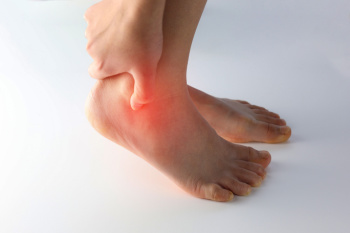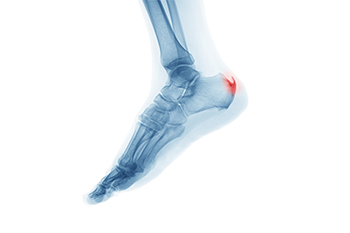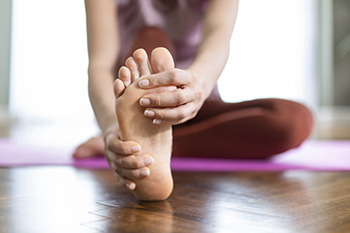Connect With Us
Blog
Items filtered by date: June 2025
Managing Gout in the Ankles

Gout in the ankle can cause sudden, intense pain, swelling, and redness that may be mistaken for a sprain. This type of inflammatory arthritis occurs when uric acid builds up in the bloodstream and forms crystals in the joint. The ankle becomes inflamed, often without prior injury, due to these deposits. Gout is more common in men over 40 and women after menopause. It can be triggered by a diet high in purines, certain medications, excessive alcohol use, or other medical conditions like kidney disease and diabetes. People with recurring gout attacks may develop long-term joint damage or reduced mobility, if the condition is not addressed. A chiropodist can help identify whether gout is affecting your ankle through clinical evaluation and may recommend ongoing treatment to reduce pain and manage uric acid levels. Addressing underlying health issues and modifying diet may reduce flare frequency. If you have ankle pain from gout, it is suggested that you schedule an appointment with a chiropodist for expert advice.
Gout is a painful form of arthritis that can affect anyone. Please consult with one of our chiropodists from West Toronto Foot & Ankle Clinic Inc. . Our chiropodist will assess your condition and provide you with quality foot and ankle treatment.
What Is Gout?
Gout is characterized by sudden, severe attacks of pain, redness, and tenderness in the joints. This type of arthritis is caused by a buildup of uric acid in the bloodstream. When uric acid crystallizes in a joint, often the joint of the big toe, it can bring about a gout attack.
Symptoms
Symptoms of gout include:
- Sudden and severe pain
- Swelling
- Redness
- Warmth
- Joint stiffness
- Joint deformity
Diagnosis
A chiropodist will ask questions about your personal and family medical history, followed by an examination of the affected joint. Laboratory tests and x-rays are sometimes ordered to determine if the inflammation is caused by something other than gout. A sample of fluid taken from your joint can show whether it contains uric acid.
Treatment
Prescription medications or injections are used to treat the pain, swelling, and inflammation. Patients with chronic gout can also use behavioral modifications such as diet, exercise, and decreased intake of alcohol to help minimize the frequency of gout attacks. Foods and beverages that are high in purines should be avoided since purines are converted in the body to uric acid. If left untreated, this painful condition can leave your joint permanently damaged and swollen.
If you have any questions, please feel free to contact our office located in . We offer the newest diagnostic and treatment technologies for all your foot care needs.
How a Chiropodist Can Help With Heel Spurs

Heel spurs are bony growths that form on the underside of the heel bone, often linked to long-term strain on foot muscles and ligaments. They commonly develop in people with plantar fasciitis, flat feet, or abnormal walking patterns. Causes include repeated stress from walking or running, wearing poor footwear, and standing for long periods of time. Symptoms may include sharp heel pain when standing or walking, especially after rest. A chiropodist can help by diagnosing the condition, offering custom orthotics, recommending stretching exercises, and guiding proper footwear choices to relieve pressure, reduce pain, and support healing of the affected area. If you have developed a heel spur, it is suggested that you contact a chiropodist who can offer appropriate relief and treatment tips.
Heel spurs are bony outgrowths from calcium deposits. They occur at the back of the heel bone or underneath the heel bone and usually form in response to chronic irritation of the Achilles tendon or plantar fascia. They are often asymptomatic, but if you are suffering from heel pain, please consult with one of our chiropodists from West Toronto Foot & Ankle Clinic Inc. . Our chiropodist can help you maintain the health of your lower limbs and your mobility.
Symptoms of Heel Spurs
- Tenderness
- Heel pain
- Pain when walking
- No symptoms
Diagnosis
Since heel spurs are often asymptomatic, they are usually only diagnosed when they are found on the heels incidentally during an X-ray taken for another reason. Nevertheless, if you have heel pain, and particularly if you have plantar fasciitis or Achilles tendonitis, it may be worth it to see if you have heel spurs too.
Treatment
Unless they are causing symptoms, heel spurs typically don’t require any treatment. When they are symptomatic, treatments are typically conservative. They may include resting and icing the affected foot, taking anti-inflammatory medications, and wearing orthotics or supportive footwear, especially while exercising.
If you have any questions, please feel free to contact our office located in . We offer the newest diagnostic and treatment technologies for all your foot care needs.
Toe Fractures in Children

Broken toes are a frequent injury in children and often happen during play, sports, or accidentally bumping into furniture. These injuries can be painful but are sometimes overlooked because the toe may not look badly damaged. Common signs include swelling, bruising, limping, or tenderness when touched. Some children may not be able to move the toe or may avoid putting weight on the foot. Because children’s bones are still developing, even small fractures should be looked at carefully to avoid future problems with growth or alignment. Treatment includes rest, taping the toe to a neighboring toe, wearing a protective shoe, or limiting activity. If a child injures a toe and the pain does not improve or walking becomes difficult, it is suggested that you see a chiropodist for an exam, ensuring the toe heals properly.
A broken toe typically occurs following either a sudden, traumatic injury, like dropping a heavy piece of furniture on the toe. The impact causes the bone to fracture and produces a variety of painful symptoms. If you suspect that you’ve broken your toe, please consult with one of our chiropodists from West Toronto Foot & Ankle Clinic Inc. . Our chiropodist can help you maintain the health of your lower limbs and your mobility.
Symptoms
- Throbbing pain
- Swelling
- Bruising
- Cracking sound at the time of injury
- Difficulty bearing weight on the toe
- Difficulty walking
- Toe resting at an unnatural angle
Diagnosis
Your chiropodist can diagnose a broken toe through physical examination and imaging studies, such as X-rays.
Treatment
The main goals of treatment are to ensure that the bone heals properly, as a toe fracture that doesn’t heal properly can lead to osteoarthritis. You will typically need to rest the affected toe. You may be prescribed a splint to immobilize the toe while it heals. Icing the affected toe and taking over-the-counter medications can help reduce pain. In cases of severe fractures, surgery may be necessary to reset the broken bones and make sure that they heal correctly.
If you have any questions, please feel free to contact our office located in . We offer the newest diagnostic and treatment technologies for all your foot care needs.
Do You Suffer From Painful Feet?
What Causes Toe Pain and How It Can Be Treated

Toe pain can come from many sources. Common causes include ingrown toenails, bunions, hammertoes, arthritis, and nerve issues like morton’s neuroma. Repetitive pressure from wearing tight shoes or high heels can also lead to corns, calluses, or joint inflammation. Injuries such as sprains or fractures may cause sudden, sharp pain. Sometimes the issue is structural, where misalignment places strain on joints and soft tissue. Treatment depends on the cause. It may involve changing footwear, using orthotics, taking anti-inflammatory medication, or applying pads to protect tender areas. In some cases, targeted exercises or minor procedures may help relieve symptoms and restore movement. Ongoing pain should not be ignored. If you have toe pain that is limiting your activity or not getting better, it is suggested that you see a chiropodist for a proper diagnosis and appropriate treatment.
Toe pain is common and can have a variety of causes. Causes can range from a broken toe to an ingrown toenail. Many types of toe pain can be corrected, but any toe pain that inhibits your activities for an extended period should be discussed with a chiropodist. If you suffer from toe pain, please consult with one of our chiropodists from West Toronto Foot & Ankle Clinic Inc. . Our chiropodist can help you maintain the health of your feet.
Common Causes of Toe Pain
- Trauma or fracture
- Cuts, sores, or bruises
- Rheumatoid arthritis
- Gout
- Turf Toe
- Morton’s neuroma
- Blisters
- Corns
- Bunions
- Hammertoes
- Ingrown toenails
- Plantar warts
- Athlete’s Foot
Symptoms of Toe Pain
- Toe deformity
- Burning
- Numbness
- Toenail deformity
- Wart or ulcer
- Swelling
- Redness
When to See a Chiropodist
- Bleeding or severe swelling
- Trauma, such as a broken bone
- Discoloration or extreme swelling
- Inability to bear weight
- Persistent pain
- Wounds that won’t heal
Diagnosis of Toe Pain
A chiropodist can conduct a thorough examination of the painful toe or toes in order to determine the best course of treatment. The exam may include assessing the tenderness of the area, taking an X-ray or other diagnostic test, or assessing your gait and range of motion. A discussion of what led to the advanced pain issue may follow. Included will likely be a health history, as well as a list of medications you are taking and other previous injuries you may have sustained.
Treatment for Toe Pain
With such a wide range of possible causes for toe pain, treatment can be varied in scope and length. Sometimes, the chiropodist will recommend lifestyle and activity changes. In cases of trauma or other injuries, X-rays or imaging tests will likely be used to determine the severity of the problem, particularly if any bones have been broken. Treatment may also include injections of pain-relief medication or anti-inflammatory drugs. Certain injuries will require the splinting, bracing, or wrapping of injured toes. Orthotics or special shoes may be prescribed in cases of bone deformities and gait issues. Removal of warts, calluses, and corns may be needed. In other cases, such as with patients who have diabetes or rheumatoid arthritis, ongoing treatment may be required to avoid more serious problems.
If you have any questions, please feel free to contact our office located in . We offer the newest diagnostic and treatment technologies for all your foot care needs.
Blog Archives
- October 2025
- September 2025
- August 2025
- July 2025
- June 2025
- May 2025
- April 2025
- March 2025
- February 2025
- January 2025
- December 2024
- November 2024
- October 2024
- September 2024
- August 2024
- July 2024
- June 2024
- May 2024
- April 2024
- March 2024
- February 2024
- January 2024
- December 2023
- November 2023
- October 2023
- September 2023
- August 2023
- July 2023
- June 2023
- May 2023
- April 2023
- March 2023
- February 2023
- January 2023
- December 2022
- November 2022
- October 2022
- September 2022
- August 2022
- July 2022
- June 2022
- May 2022
- April 2022
- March 2022
- February 2022
- January 2022
- December 2021
- November 2021
- October 2021
- September 2021
- August 2021
- July 2021
- June 2021
- May 2021
- April 2021
- February 2021
- January 2021

